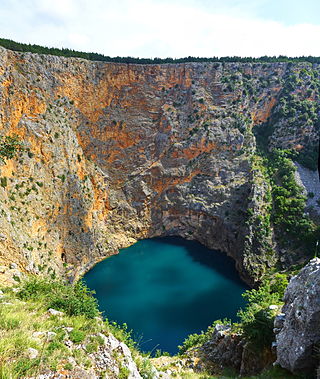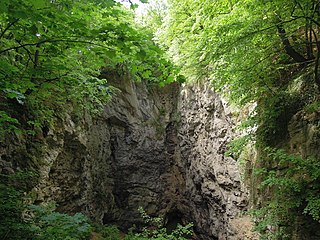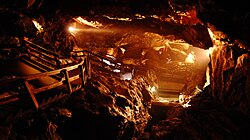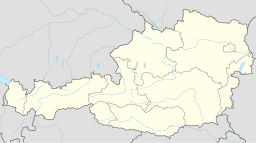
A cave or cavern is a natural void under the Earth's surface. Caves often form by the weathering of rock and often extend deep underground. Exogene caves are smaller openings that extend a relatively short distance underground. Caves which extend further underground than the opening is wide are called endogene caves.

A sinkhole is a depression or hole in the ground caused by some form of collapse of the surface layer. The term is sometimes used to refer to doline, enclosed depressions that are also known as shakeholes, and to openings where surface water enters into underground passages known as ponor, swallow hole or swallet. A cenote is a type of sinkhole that exposes groundwater underneath. Sink and stream sink are more general terms for sites that drain surface water, possibly by infiltration into sediment or crumbled rock.
Krubera Cave is the second-deepest-known cave on Earth, after the Veryovkina Cave. It is located in the Arabika Massif of the Gagra Range of the Western Caucasus, in the Gagra District of Abkhazia, a partly recognised state, previously part of Soviet Georgia.

Gouffre Jean-Bernard or Réseau Jean Bernard, sometimes known simply as Jean Bernard, is the seventh deepest cave in the world, and the third deepest one in Europe. It is in the Alps in Samoëns, France. The first entrance to the cave was found by the French caving group Groupe Vulcain in 1963. More entrances have been found over the years since, and currently at least thirteen are known. The highest entrance, known as C37, is at 2,333 m (7,654 ft) above sea level. The cave is named after Jean Dupont and Bernard Raffy, two Groupe Vulcain members who died in 1963 in an unrelated expedition in Goule de Foussoubie Cave.

The Marble Arch Caves are a series of natural limestone caves located near the village of Florencecourt in County Fermanagh, Northern Ireland. The caves are named after the nearby Marble Arch, a natural limestone arch at the upstream end of Cladagh Glen under which the Cladagh River flows. The caves are formed from three rivers draining off the northern slopes of Cuilcagh mountain, which combine underground to form the Cladagh. On the surface, the river emerges from the largest karst resurgence in Ireland, and one of the largest in the United Kingdom. At 11.5 kilometres (7.1 mi) the Marble Arch Caves form the longest known cave system in Northern Ireland, and the karst is considered to be among the finest in the British Isles.

A blue hole is a large marine cavern or sinkhole, which is open to the surface and has developed in a bank or island composed of a carbonate bedrock. Blue holes typically contain tidally influenced water of fresh, marine, or mixed chemistry. They extend below sea level for most of their depth and may provide access to submerged cave passages. Well-known examples are the Dragon Hole and, in the Caribbean, the Great Blue Hole and Dean's Blue Hole.

A pit cave, shaft cave or vertical cave—or often simply called a pit and pothole or pot ; jama in Slavic languages scientific and colloquial vocabulary —is a type of cave which contains one or more significant vertical shafts rather than being predominantly a conventional horizontal cave passage. Pits typically form in limestone as a result of long-term erosion by water. They can be open to the surface or found deep within horizontal caves. Among cavers, a pit is a vertical drop of any depth that cannot be negotiated safely without the use of ropes or ladders.

Jaskinia Wielka Śnieżna is a limestone cave system in Mount Małołączniak in the Western Tatra Mountains, of the Carpathian Mountains System, in southern Poland. The cave is within Tatra National Park.

The Blauhöhle is the largest known cave system in the Swabian Alps in southern Germany. The Blauhöhle presumably originated in a time when the Danube still flowed through the Blau valley. Since the shifting of the Danube, several small rivers, the Schmiech, the Ach, and the Blau, have flowed through this valley. The cave system begins about 21 meters under water at the base of the Blautopf. It continues west and northwest, rising and falling several times until after a horizontal distance of about 1,200 metres (3,900 ft) it comes above the level of ground water and opens into the second big air-filled chamber. The maximum depth of the cave under water is 42 metres (138 ft).
Sistema Cheve is a deep cave located in the Sierra Juárez mountain range in the southern Mexico state of Oaxaca. As of June 2023, its deepest point has been measured at 1,529 metres (5,016 ft) deep, This makes it the second deepest known cavern in Mexico and the Americas, as well as the world's 11th deepest cave. More than 55 miles (89 km) of passageways have been mapped within the cave.
Artur "Conrad" Kozłowski was a Polish cave diver who spent his last years in Ireland. Amongst other achievements in cave exploration, he set the record for the deepest cave dive in Great Britain and Ireland at a depth of 103 m (338 ft).

Hranice Abyss is the deepest flooded pit cave in the world. It is a karst sinkhole near the town of Hranice, Czech Republic. The greatest confirmed depth is 519.5 m (1,704 ft), of which 450 m (1,476 ft) is underwater. In 2020, a scientific expedition to the cave revealed that part of the system apparently reaches 1 kilometre deep, albeit with the lowest reaches sediment-filled. Analysis of the water found carbon and helium isotopes which implied that the cave has been formed by acidic waters, heated by the mantle, welling up from below.

Niggly/Growling Swallet cave system (JF-237), Tasmania is the deepest cave in Australia.

Veryovkina Cave is a cave in Abkhazia, internationally recognized as part of Georgia. At 2,223 meters (7,257 ft) deep, it is the deepest-known cave on Earth. Veryovkina is in the Arabika Massif, in the Gagra mountain range of the Western Caucasus, on the pass between the Krepost and Zont mountains, close to the slopes of Mount Krepost. Its entrance is 2,285 metres (7,497 ft) above sea level. The entrance of the cave has a cross section of 3 m × 4 m, and the depth of the entrance shaft is 32 metres (105 ft).

The Wells Gray Park Cave discovery of 2018 was of a karst cave in Wells Gray Provincial Park, in the Cariboo Mountains in British Columbia, Canada. The cave has informally been named Sarlacc's Pit pending an official name.

Boybuloq is a limestone cave in Uzbekistan, the deepest cave in Central Asia and all Asia except its western part. The cave is 1,430 metres (4,690 ft) deep and 15,212 metres (49,908 ft) long with the main entrance at an elevation of 2,647 metres (8,684 ft). It is situated at the edge of Baysun-Tau mountain ridge, the southern spur of the Gissar Range, in the southeast of the country. The nearest village is Dehibolo, to the northeast of Boysun.

Jurij Mihajlovič Kasjan is a Ukrainian speleologist, most known for his work in cave exploration, especially as the Call of the Abyss research project coordinator. He was heading the speleological expeditions to caves of the Arabika massif in Abkhazia and, with Aleksandr Klimčuk, to Aladaglar massif in Turkey. Some of the world's deepest caves were explored, including the first cave, deeper than 2,000 m, the Krubera-Voronja Cave.

Gouffre Mirolda is a karstic cave located in the Haut-Giffre mountain range, in the commune of Samoëns, Haute-Savoie, France. It is connected to the Lucien Bouclier cave system, and has a depth of −1,662 m (−5,453 ft). It is the sixth deepest cave in the world and the deepest one in Europe.

Cave diving is underwater diving in water-filled caves. The equipment used varies depending on the circumstances, and ranges from breath hold to surface supplied, but almost all cave diving is done using scuba equipment, often in specialised configurations with redundancies such as sidemount or backmounted twinset. Recreational cave diving is generally considered to be a type of technical diving due to the lack of a free surface during large parts of the dive, and often involves planned decompression stops. A distinction is made by recreational diver training agencies between cave diving and cavern diving, where cavern diving is deemed to be diving in those parts of a cave where the exit to open water can be seen by natural light. An arbitrary distance limit to the open water surface may also be specified. Despite the risks, water-filled caves attract scuba divers, cavers, and speleologists due to their often unexplored nature, and present divers with a technical diving challenge.

The Gouffre de la Pierre Saint-Martin, also called Gouffre Lépineux, is the original entrance to a major cave system located in the massif of La Pierre Saint-Martin, in the immediate vicinity of the Franco-Spanish border and the French commune of Arette, in the Pyrénées-Atlantiques in the Nouvelle-Aquitaine region, under which lies part of the cave network.



















